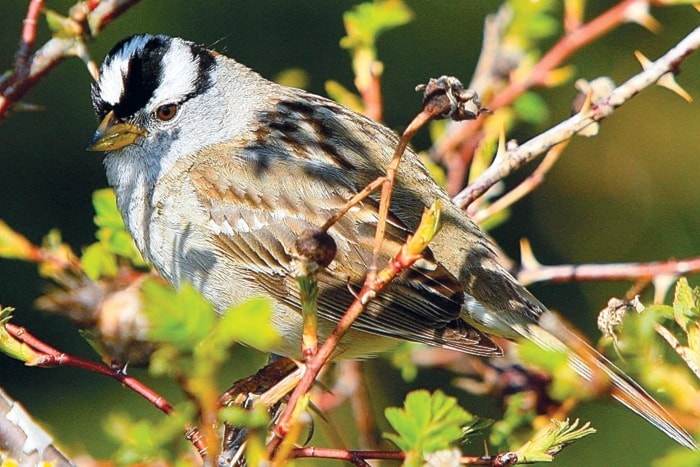How often have we heard the phrase, “Oh, it’s just a sparrow,” when out on a bird-watching foray?
As a species, the sparrow doesn’t get much respect. In truth, they are runts, small in stature (ranging in size from 11 cm (4.5 in.) to 19 cm (7.5 in.), with unremarkable brown and gray plumage.
One bird book describes them as “a generally dull-looking lot,” while other guides just dismiss them as LBBs (little brown birds). Thankfully, however, these little towhee relatives more than make up for their drab appearance with their beautiful songs, and these great little singers bring much joy whenever they’re about.
Within the sparrow family, the crowned sparrows are arguably the most beautiful, with smart head stripes that make them look “well-coiffed”. The White-crowned sports a white and black striped crown, while the Golden-crowned bears a yellow stripe with broad black band. Identification of these two sparrows is shockingly simple.
Another gorgeous sparrow is the aptly-named Fox Sparrow, sooty chocolate above with rusty tail and smart beast streaks shaped like inverted ‘V’s. The species name derives from the ‘foxy’ red coloration of eastern and northern birds.
Let’s not forget the little Song Sparrow with its dark breast spot … almost where its heart might be. On the West Coast, this is the most common, year-round sparrow, and they keep busy raising three or four families each season. This kind of productivity bodes well for continuing melodic enjoyment.
Three other sparrows found on the West Coast include Lincoln’s, Savannah, and my own personal favourite, the Chipping Sparrow, with its splendid rusty-red crown. But what of the (far too common) House Sparrow….an Old World sparrow not closely related to native sparrows. Much to the detriment of native species, this unwelcome immigrant competes aggressively for nest sites and displaces many desirable species.
One further note that may take some by surprise…the prolific Dark-eyed Junco is a member of the…you guessed it…sparrow family!
Canada’s native sparrows should be treated like royalty, and provided with food, drink, lodging (well, soft nesting bits), and every kindness that a bird might desire. Our country’s wild bird populations are taking a nosedive, and there may come a day in the not so distant future when even sparrows will no longer be around.
E-mail Christine at: wildernesswest@shaw.ca.
